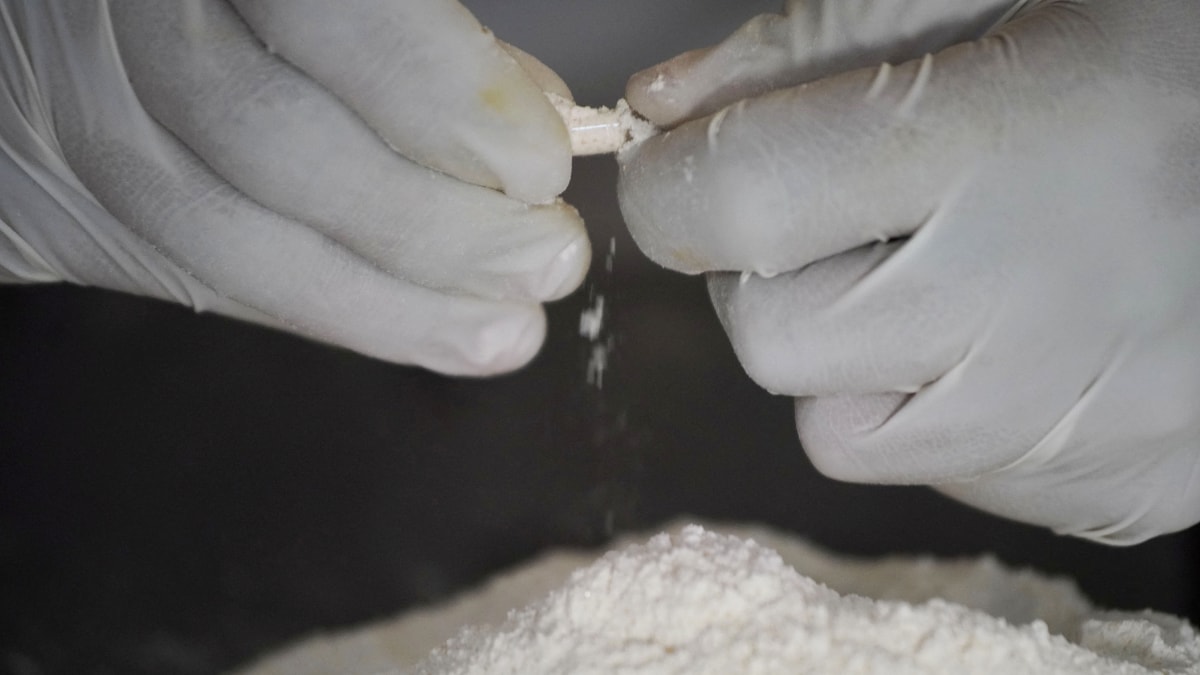[ad_1]
Afghanistan, the most notorious for the global opiate trade, now faces a daunting challenge, both for itself and the wider region, due to a recent surge in illegal methamphetamine production and trafficking. The United Nations’ Office on Drugs and Crimes, which released a report on Sunday, highlighted this emerging threat, indicating that the Taliban-ruled country has rapidly transformed into a major regional hub for methamphetamine production.
The country is also a major opium producer and heroin source, even though the Taliban declared war on narcotics after they seized power in 2021. The UN report said meth in Afghanistan is mostly made from legally available substances or extracted from the ephedra plant, which grows in the wild.
“Seizures inside and outside Afghanistan point to a sharp increase in methamphetamine manufacture in Afghanistan in the last few years. An analysis of significant individual drug seizures shows that an increasing amount of methamphetamine seized in neighbouring countries reportedly originated in Afghanistan,” the United Nations Office on Drugs and Crime (UNODC) said in a report. The UN report suggests that drug traffickers may be capturing an increasing share of the methamphetamine market in Afghanistan and the wider region.
The Drug Problem
Last November, a UN report said that opium cultivation since the Taliban takeover increased by 32 percent over the previous year, and that opium prices rose following authorities’ announcement of a cultivation ban in April 2022. Farmers’ income from opium sales tripled from USD 425 million in 2021 to USD 1.4 billion in 2022.
The report also said that the illicit drug market thrived as the country’s economy sharply contracted, making people open to illegal cultivation and trafficking for their survival.
Afghans are dealing with severe economic hardship and the continued consequences of decades of war and natural disasters. The downturn, along with the pause of international financing that propped up the economy of the Ashraf Ghani government, is driving people into poverty, and addiction.
What Data Says
Seizure data from 2017 to 2021 shows a staggering increase in methamphetamine production and trafficking in Afghanistan and neighboring countries. Methamphetamine seizures have surged from a mere 2.5 tons in 2017 to a staggering 29.7 tons in 2021. This growth indicates that the landlocked country is not only a transit route for illicit drugs but also a significant producer of methamphetamine.
Within Afghanistan itself, the rise is even more dramatic. Annual seizures of methamphetamine in the country skyrocketed from less than 100 kg in 2019 to nearly 2,700 kg in 2021, pointing to a considerable increase in production capacity. The government had previously reported methamphetamine production across various provinces, with precursor chemicals primarily sourced from neighboring countries.
Ephedra — a Key Ingredient for Meth
Methamphetamine production relies heavily on ephedra, a plant that grows in remote and often inaccessible areas. To produce a single kilogram of pure methamphetamine, an estimated 200 kg of dried harvested ephedra is needed. Considering that approximately half of the plant’s weight consists of water, the equivalent amount of freshly collected ephedra may reach 437 kg.
As per the UNODC report, the estimated ephedra required to manufacture the 29.7 tons of methamphetamine seized in and around Afghanistan in 2021 could range from 6,500 to 11,700 metric tons, depending on purity. This amount surpasses the total opium production of Afghanistan in 2022, which was estimated at 6,200 tons.
Challenges in Ephedra Harvesting
Harvesting ephedra is a labor-intensive process, with harvesters collecting between 25-45 kg of ephedra per day. It may take between 9.7 and 17.5 labour-days to collect enough ephedra for a single kilogram of pure methamphetamine. To meet the quantity of seized methamphetamine, an estimated 202,000 to 363,000 labour-days would be needed.
According to the UN report, satellite imagery and field observations suggest that approximately 34 hectares of ephedra-rich land are required to source enough raw ephedra for a kilogram of methamphetamine under non-ideal conditions and a short three to four-month harvest period. Assuming purity ranges of 50 to 90 percent, between 507,000 and 913,000 hectares would be needed to manufacture the seized methamphetamine, greatly exceeding the area under cultivation of opium poppy in its peak year of 2017.
Ephedrine as an Alternative
While ephedra appears cost-effective in the short term, it has limitations due to its remote growth locations, limited harvest periods, and low plant density. An alternative method involves the use of bulk ephedrines, which are often diverted from the legal market. These chemicals can be directly synthesised into methamphetamine with fewer steps, and their higher purity requires significantly less input material.
Estimates suggest that between 414-745 metric tons of cold medications would have been needed to produce the seized methamphetamine, assuming purity ranges between 50-90 percent. This far exceeds the 13 metric tons of annual legitimate requirements for ephedrine/pseudoephedrine reported by the International Narcotics Control Board (INCB) for Afghanistan and neighbouring countries in 2022. The diversion of such vast quantities of cold medications in the region is improbable.
The UN report stated that bulk ephedrines are produced and traded in large quantities within the region, making them a more accessible choice for methamphetamine production. In 2022, over 100 metric tons of bulk industrial-grade ephedrines were reported in annual legitimate requirements for Afghanistan and neighbouring countries.
Regional Cooperation is Key
To counter the increasing use of diverted cold medications and industrial-grade precursors in methamphetamine manufacture, the UN report argues that regional coordination and cooperation are crucial. It states that policies targeting the diversion and smuggling of chemical precursors can help reduce the illegal supply of methamphetamine. In the report, the UN body laid emphasis on reviewing regulations concerning cold medication formulations that may identify steps to reduce the availability of these inputs for methamphetamine production.
The agency also called for enhancing understanding of the primary inputs used in illegal methamphetamine production in the country through regular mapping, chemical signature analysis of seizures and licit flows, and monitoring ephedra plant harvesting and trading. Greater regional cooperation and policy efforts to combat the diversion and smuggling of chemical precursors are critical steps in curbing the illegal methamphetamine trade emerging from Afghanistan, it added.
[ad_2]
Source link






